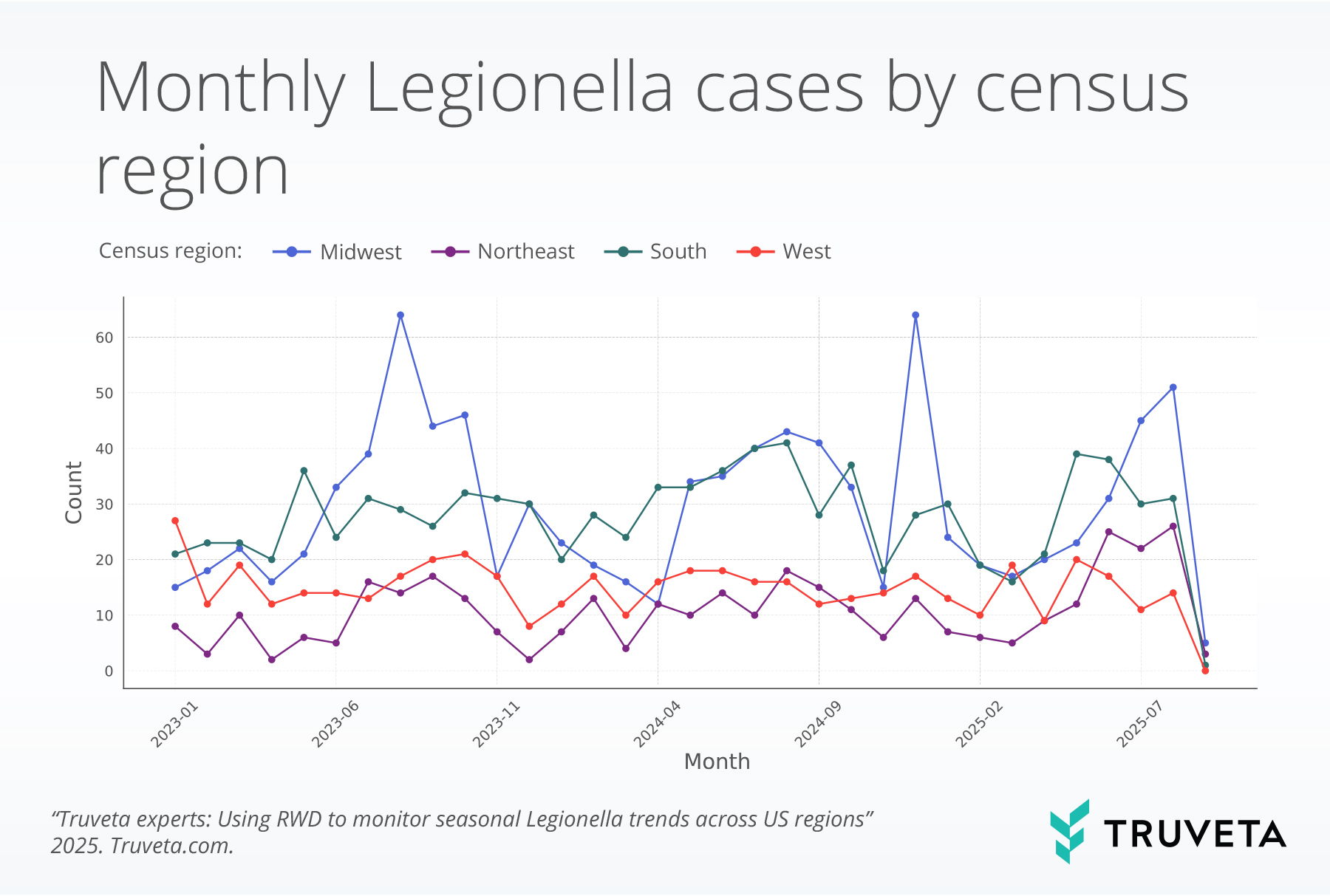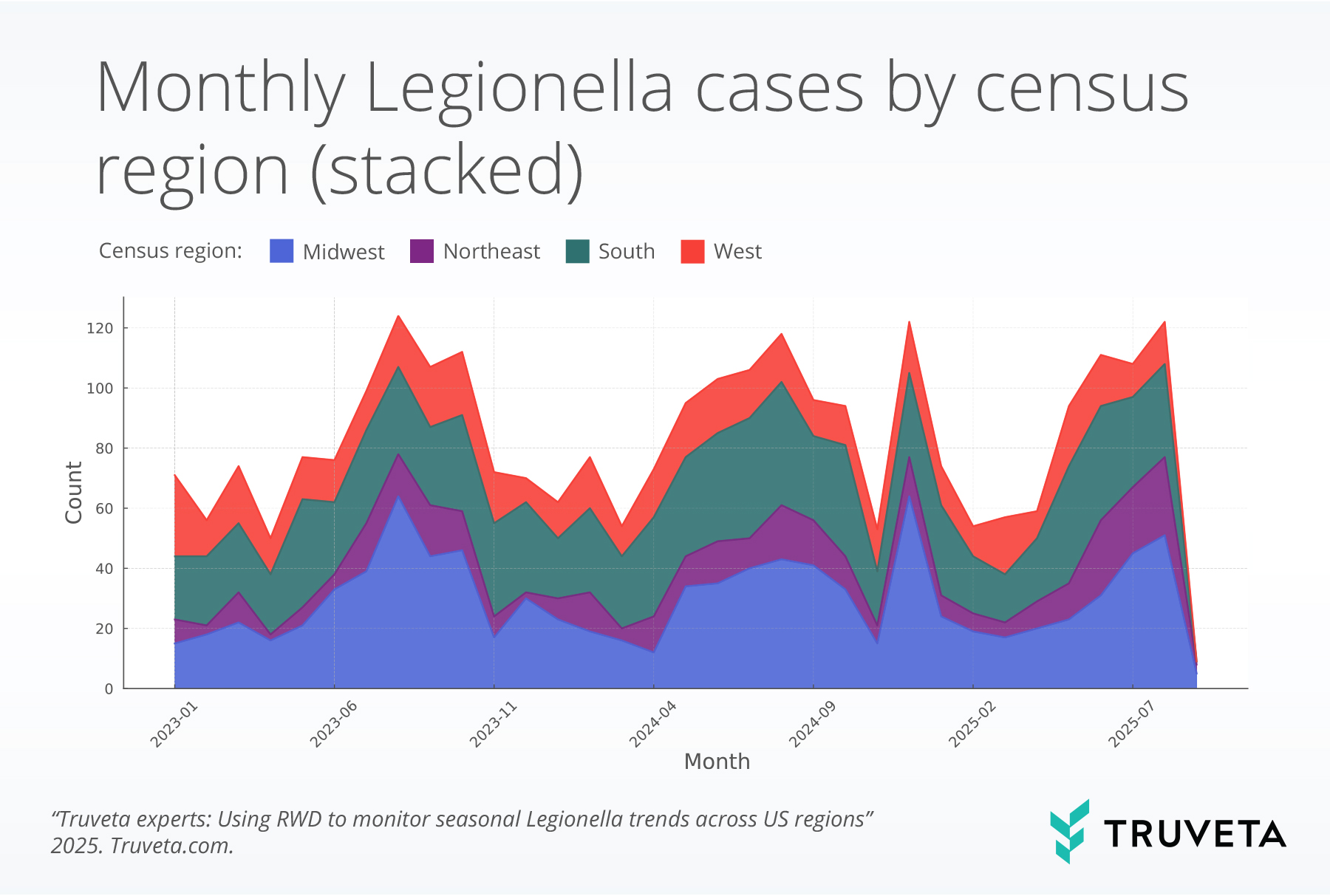In this Truveta experts spotlight, Amy Wu, Director, Partner Research and Success, analyzed recent seasonal and regional patterns in Legionella cases across the US using Truveta Data. The analysis explored how monthly counts of Legionella cases varied by US Census Region, and whether a recent regional spike in the Northeast could be seen in the data. The findings demonstrate how real-world data (RWD) can illuminate disease seasonality and regional variation, offering valuable insight to strengthen public health monitoring and preparedness.
Why it matters
Legionellosis, caused by Legionella bacteria, typically surges in warmer months and can lead to severe pneumonia and community outbreaks linked to building water systems. Understanding seasonal and regional trends helps public health agencies and health systems anticipate higher-risk periods, strengthen environmental monitoring, and prepare for increased testing and clinical demand during peak summer months. According to the CDC’s national Legionella surveillance program, case counts have risen in recent years, with marked variability by region.
Methods
Amy examined monthly counts of Legionella cases from January 2023 through September 2025, grouping them by US Census Region (Midwest, Northeast, South, and West; encounters with incomplete geography were categorized as “null”). Data was pulled on September 8, 2025.
Using de-identified electronic health records from Truveta Data, which are updated daily, she tracked trends to identify seasonality and potential regional surges in real time.
Figure 1 below illustrates monthly trends by region, showing clear summer peaks and winter lows. Figure 2 visualizes total case burden across regions, highlighting each region’s relative contribution to the national pattern.


Results
Clear seasonal peaks were visible in all regions, with the Midwest and South showing the largest increases during summer months (Figure 1). Cases consistently dipped during the winter, reinforcing known seasonal dynamics of Legionella transmission.
A late-summer 2025 rise in the Northeast was also observed , aligning with reported regional outbreaks from public health agencies.
Discussion
Legionella cases are consistently higher across all regions in warmer months, relative to colder months. The timeliness of Truveta’s Data captures a late-summer 2025 rise in the Northeast was also observed from June through August, consistent with a known outbreak, though the magnitude appears tempered—likely due to aggregation at the regional level and patients with a missing region. These patterns reinforce the value of targeted warm-season surveillance and building-water remediation, especially in regions that historically lead the summer surges.
“Being able to observe these seasonal surges in real time is what makes Truveta Data powerful. It allows us to connect environmental and clinical data quickly enough to inform public health actions, not just document them after the fact.” – Amy Wu
How real-world data enabled this insight
Traditional surveillance systems often lag behind real-time trends, limiting the ability to act on emerging risks. Timely, representative, EHR-based data enabled month-over-month tracking across large, diverse health systems. Standardized location fields and refresh cadence allowed us to examine regional seasonality and recent spikes close to real time. Consistent identifiers and wide geographic coverage support comparisons across Census Regions that are difficult to assemble from siloed sources.
See how Truveta Data can accelerate your next study—Request a customized demo today
About the author
Amy Wu is a Director on the Partner Research and Success team at Truveta. She leads collaborations with customers across life sciences and healthcare, drawing on experience in real-world evidence and analytics. Her work spans oncology, rare diseases, and chronic conditions, helping partners unlock insights from large-scale health data.
About Truveta experts
The Truveta experts series highlights insights from researchers, clinicians, and data scientists working across Truveta. Each post demonstrates how real-world data can unlock new understanding—from disease patterns to treatment trends to population health.
Explore more in this series:
Treatment trends for trigeminal neuralgia
Fireworks during the fourth of July
Real-world trends in Rituxan biosimilar adoption
Sudden cardiac arrest and arrhythmias among patients with chronic kidney disease
Biomarker testing trends in metastatic non-small cell lung cancer
